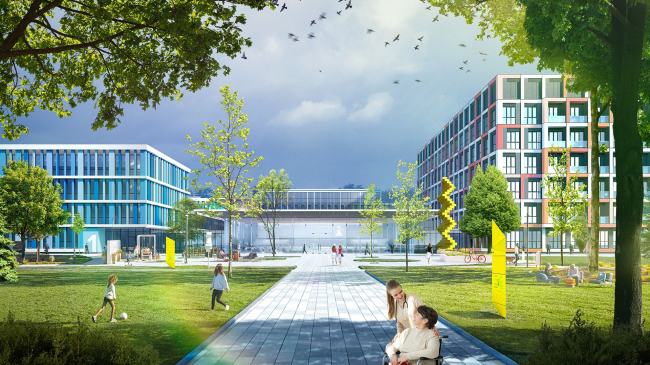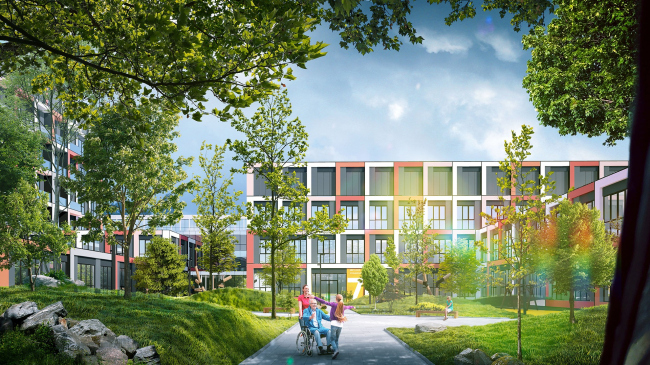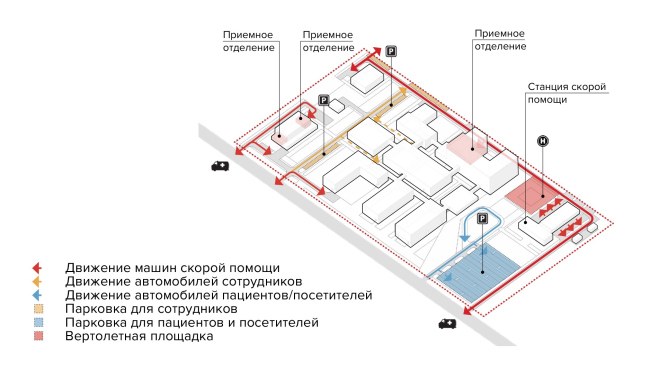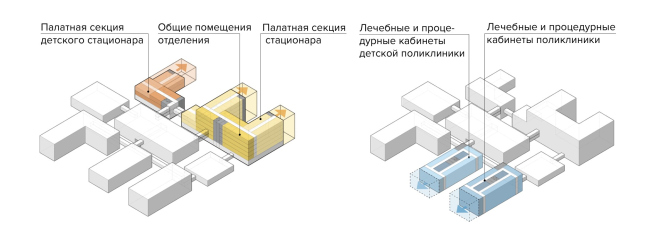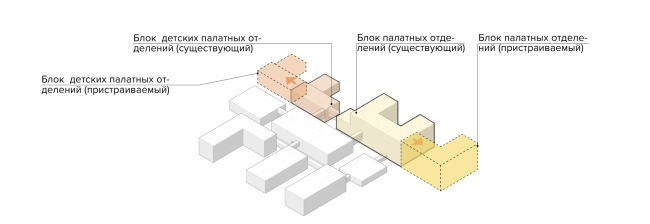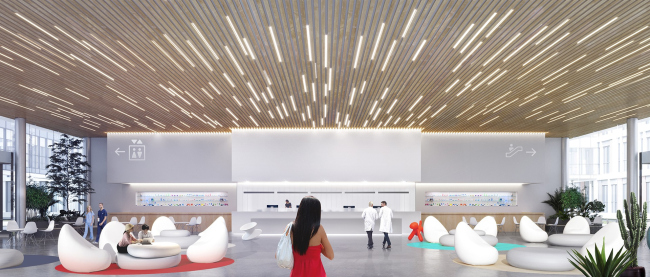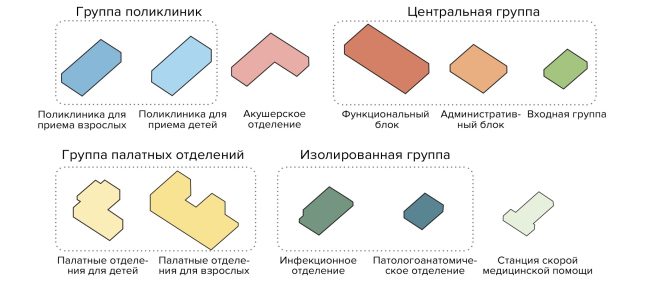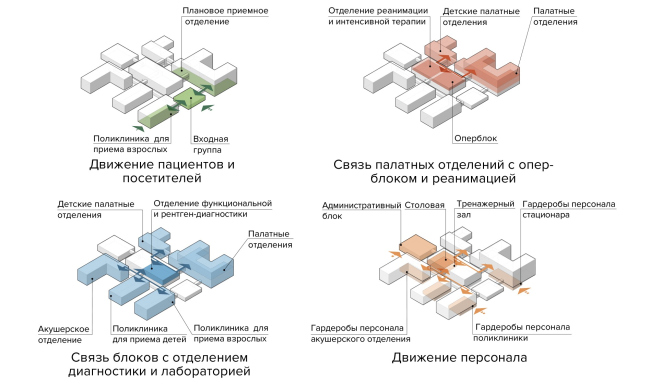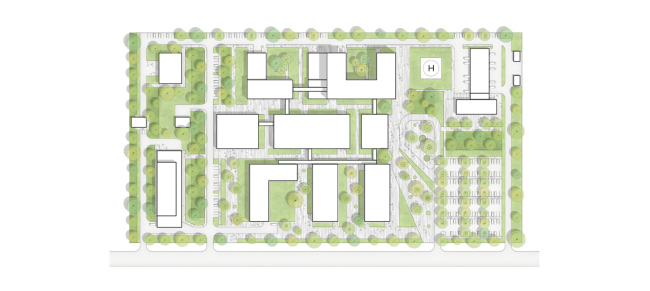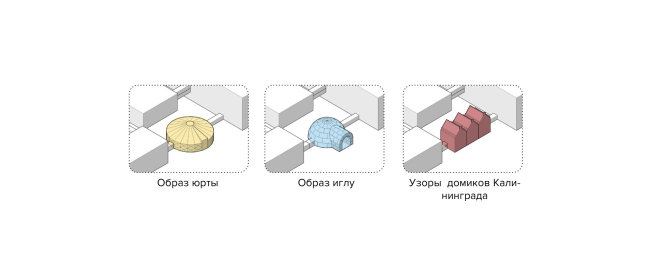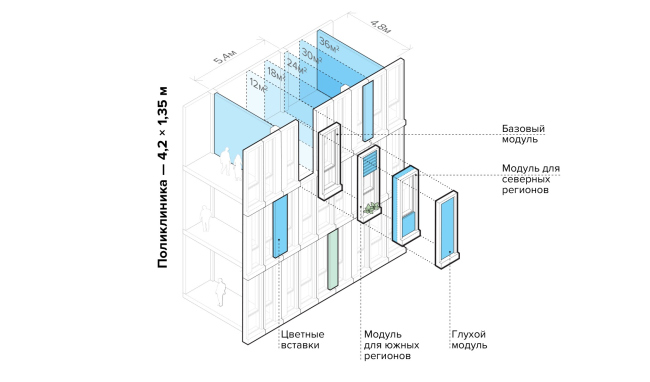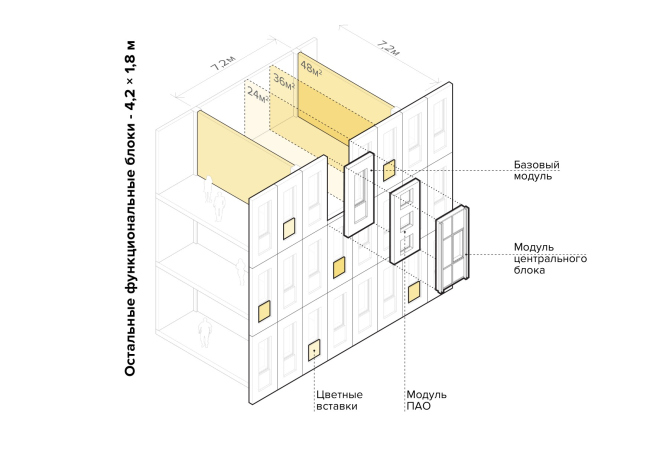|
Published on Archi.ru (https://archi.ru) |
|
| 02.09.2020 | |
|
Health Constructor |
|
|
Natalia Koriakovskaia |
|
| Architect: | |
| Yuliy Borisov | |
| Studio: | |
| UNK | |
|
In this issue, we are publishing the concept of a standard clinic designed by UNK Project, which took second place in the competition organized by the Union of Architects of Russia in collaboration with the Healthcare Ministry. The typical and standardized projects, by and large, have been firmly standing their ground for the last seven decades, yet recently their agenda got a new development impulse. KB “Strelka” has conducted a competition of standardized housing projects; similar tasks were posed by the integrated home-building factories . A year ago, a competition was held for projects of nursing homes. Now new proposals have appeared about setting similar goals for hospital buildings. The concept by UNK Project is one of such proposals; it scored second place in this competition in the nomination “the largest hospital buildings for 400+ beds”. Health ConstructorCopyright: © UNK projectHealth ConstructorCopyright: © UNK projectThe very name of the concept – “Health Constructor” – explains its two main goals and characteristics. “Constructor” implies that this project is flexible and can be scaled up to fit various conditions, while its structure can also be varied. “Health” implies the ideological basis of the image solution of the building, which is regarded not so much as a place for sick people as a place where people get well. 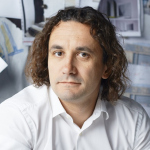 Julius Borisov, UKN Project “People’s health is the cornerstone of our concept. For this, we developed special functional zoning, and the very architecture of the building, which is no longer of the “hospital” kind but rather looks like a health center. And, since this is still a project to be duplicated, we came up with a clear and simple solution, which can be scaled up and varied in order to avoid a situation when all of our cities will get look-alike hospitals”. Scheme and function constructor Let us start with the land site. Oftentimes, when a stock solution is “landed” on some specific territory, various difficulties pop up having to do with “tying it” to the specific location, entailing additional expenses. In order to avoid that, UNK Project scales up the “construction set” principle on the “game field” itself, i.e. proposes to functionally divide the land site in accordance with some certain logic. The territory of the clinic is divided into four zones – a private one for the hospital patients, a public space with guest parking spaces, isolated blocks (for example, the infection department), and the transport/maintenance zone. All of this is also tied in with the transport scheme: there are five independent drive entrances to the territory, which divide the flows of the visitors and the personnel, the ambulance stations, and the isolated departments. Health Constructor. The planting diagramCopyright: © UNK projectHealth Constructor. The transport diagramCopyright: © UNK projectThe same kind of logic is used to present a “ready-made” or “pre-packed” landscaping concept: more abundant vegetation for smaller hospital yards, green “wing flats” for the anatomical/pathological unit, lawns in the area of the main pedestrian routes, convenient personnel parking places, loading bays, and the ambulance helicopter landing. Health Constructor. The functional zonesCopyright: © UNK projectNow about the construction set of the building itself: in order to have an opportunity to comparatively quickly fine-tune the project to different settings and surroundings – for example, to build a clinic in Yakutia or make its ward units larger in accordance with the current requirements – the structure of the volume is divided into 11 functional units that can be assembled pretty much like building blocks. At the same time, these blocks are independent enough; they can be taken out, or, on the other hand, added up, as well as divided in accordance with the construction priorities depending on the current task. Health Constructor. Adaptation during design and operationCopyright: © UNK projectHealth Constructor. Adaptation during design and operationCopyright: © UNK projectThe nucleus of such a construction set is the central group of public spaces with a lobby and a management office, around which the other units are built up, both vertically and horizontally. These are groups of outpatient clinics – one for adults, and one for children – ward units, a maternity hospital, and another three isolated blocks, which technologically must stand at a certain distance from the others – the infection and pathological units, and the ambulance station. Health ConstructorCopyright: © UNK projectThe central group is not just an entrance with a reception desk, but a full-fledged public space where one can take a rest, visit with the patients, buy flowers, check into a drugstore, or have a bite to eat. By turning this rather spacious zone into the conceptual center of the clinic, UNK Project emphasizes a humanistic character of modern interpretation of the very hospital function – people get into clinics not to be sick and to suffer but to recover and get healthy. This is why on 3D renders the entrance group looks rather like the lobby of a health resort, or a fitness club, or a community center. Health Constructor. The main entrance in an individual blockCopyright: © UNK projectFurther on, the concept establishes some certain rules of unit arrangement – what to place where in order to facilitate navigation for doctors and patients, as well as reduce the time of them moving along the clinic’s corridors. The function provides for necessary division of flows of the patients and personnel. Health Constructor. Construction set principle: 11 blocksCopyright: © UNK projectOn the first floor, next to the entrance block, the outpatient clinics and the first-aid station are placed, as well as an emergency room, admission departments of hospitals, and a department of palliative and outpatient oncological care. The second floor contains an auditorium, laboratories, situated at an equal distance from the other departments, functional diagnostics, and X-ray rooms. The third floor provides the connection between the hospitals and the operating theater and the intensive care wards. The fourth floor is occupied by the maternity center and the outpatient clinic for adults. The fifth floor is neurological; the sixth is cardiology. The underground level comprises the personnel premises such as cloakrooms, a canteen, a management office, and a gym. Health Constructor. Assembling blocks and adapting solutionsCopyright: © UNK projectHealth Constructor. Connections of the functional content of the blocksCopyright: © UNK projectThe benefits of standardization The complex and rigid technology of hospital construction requires special knowledge from the designers, and this is why hospitals lend themselves to standardized construction. But then again, according to the UNK idea, this does not keep the project from being flexible – its inherent modular character is ensured by a single construction pitch and a standardized width of the premises within the block. This, in turn, helps to adapt it to the current needs both at the design and operation stages. For example a 5400x4800 mm grid cell may contain two rooms 12 square meters each, or one 24-square-meter room, which means that you can easily reduce or increase the number of treatment rooms or hospital beds, if such need arises. The “construction set” also makes it possible to add extra ward departments, should this be necessary, or fine-tune the structure of the building to the specifics of the land site. Health Constructor. Adapting to various combinations of the land siteCopyright: © UNK projectHealth Constructor. Simplified masterplanCopyright: © UNK projectIdentity and Standardization As for the architectural image of the building, it will not be compromised because of such a “standardized” approach either. The architects proposed not to leave the hospital buildings devoid of their regional identity by introducing a possibility of experimenting with the form making of the entrance group. Its architecture can also reflect both special functional requirements and the region-specific identity. The central group of the premises can be designed in the form of a nomads tent, an igloo, or a flock of houses with pitched roofs. Thus, the central “non-standardized” element of the building, the one that meets the visitors’ eyes more often than the others, solves the problem of the hideously look-alike standardized clinics. Health Constructor. The entrance block reflects the specifics of the Russian regionsCopyright: © UNK projectThis technique “lives” in the same ballpark with the industrial construction principle – the quick-mount technology is achieved by using a system of facade modules. They will be supplied to the construction site ready-made, which will fully ensure the required construction rate and efficiency. The absence of the scaffolding – and the modules are mounted from inside the building, which provides a possibility for mounting them parallel to building up the main bulk – can reduce the time required for the facade work down to 1.5-2 months. Health Constructor. The facade modulesCopyright: © UNK projectThe background pattern of the facades of the clinic is composed on the basis of an identical approach, from modules of three sizes: the width of the ward for the hospitals (3.6 m), 1.35 meters for outpatient clinics, which fits all types of rooms there, and an all-purpose 1.8 unit for all the other blocks. The height is the same everywhere (3.2 meters), and equals the height of the standard floor. Health Constructor. The facade modulesCopyright: © UNK projectIn addition, the facade pattern can be executed in different colors, and can have accentuated surfaces, upon which, according to Julius Borisov, “you can apply different types of ornaments, getting different meanings, taking into account the specifics of the geographic context, or the local mentality, or the local climate.” The modules also allow for changing the thickness of the heat-retention layer, changing the percentage of glazing, making balconies in the hospitals, and using different decoration materials – essentially, for constructing different buildings. Health Constructor. The facade modulesCopyright: © UNK projectThus, “Health Constructor” solves two main problems of standardized construction that have to do with finding the individual in the standard. First, due to its being flexible and adaptive, it makes it possible to avoid excessive (and expensive) fine-tuning, which oftentimes pops up when stock solutions are used. And, second, it helps prevent the monotony of hospitals where function often prevails over architecture. The modern interpretation of the reusable project from the UNK Project combines technology and architecture in a graceful integrated manner, based on the scheme of mutual arrangement of blocks, which is so convenient that it takes on universal features, endowing it, within the framework of this concept, with as much flexibility as possible, both on the macro and micro level. Which, as a consequence, possesses all of the necessary prerequisites for achieving the main goal stated by the authors – namely, that of turning the hospital into a human-friendly and efficient space: a place where people get healed. 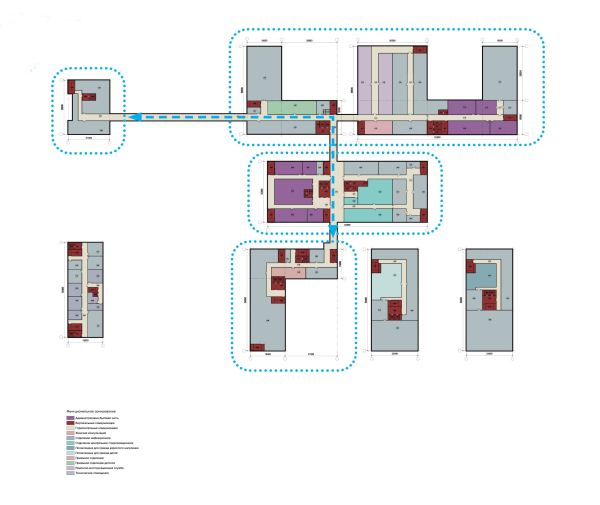 Health Constructor. Plan of the underground floorCopyright: © UNK project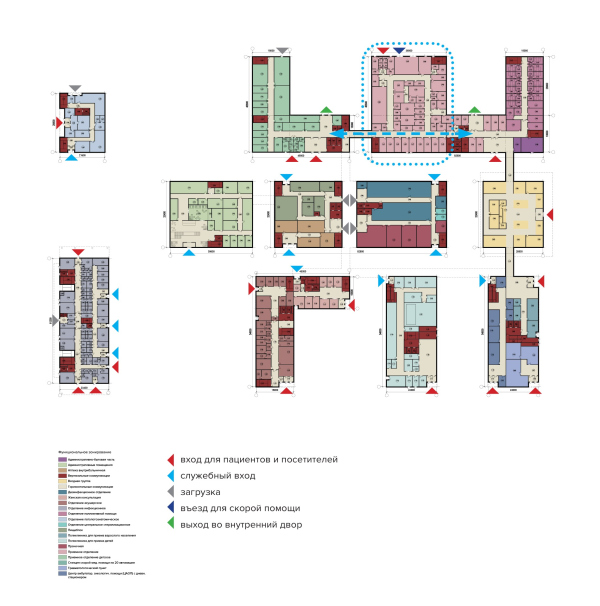 Health Constructor. Plan of the first floorCopyright: © UNK project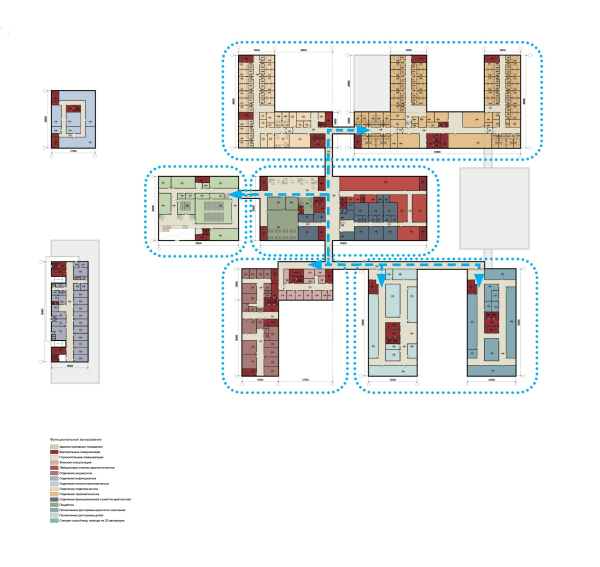 Health Constructor. Plan of the second floorCopyright: © UNK project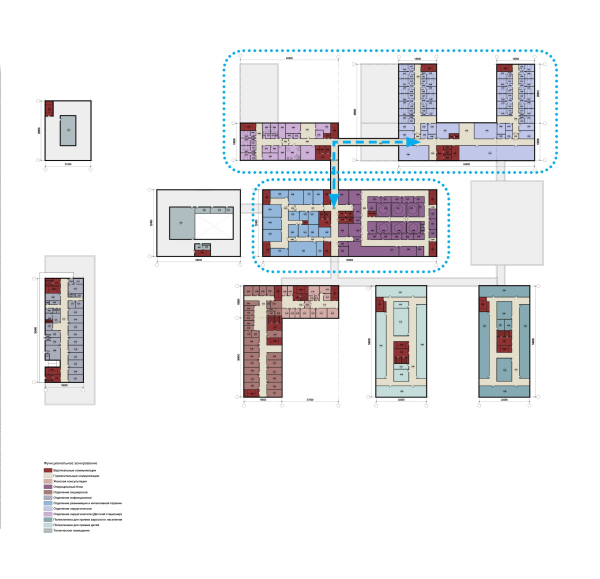 Health Constructor. Plan of the third floorCopyright: © UNK project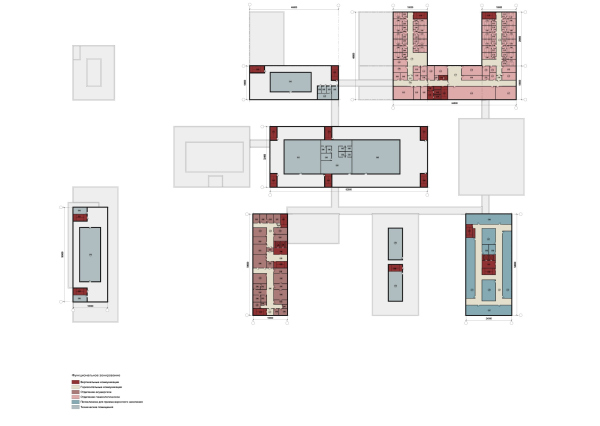 Health Constructor. Plan of the fourth floorCopyright: © UNK project Health Constructor. Plan of the fifth floorCopyright: © UNK project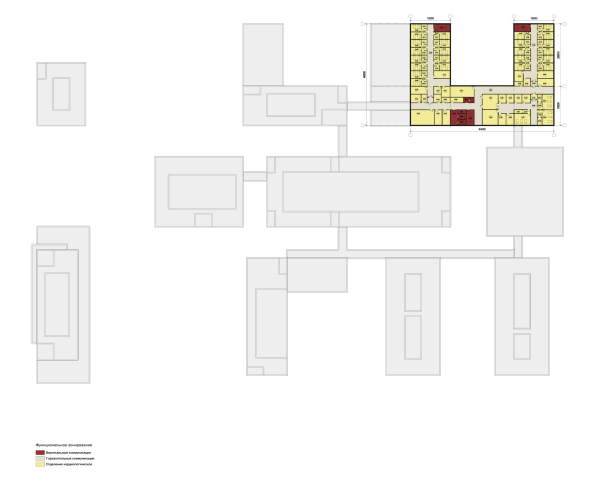 Health Constructor. Plan of the sixth floorCopyright: © UNK project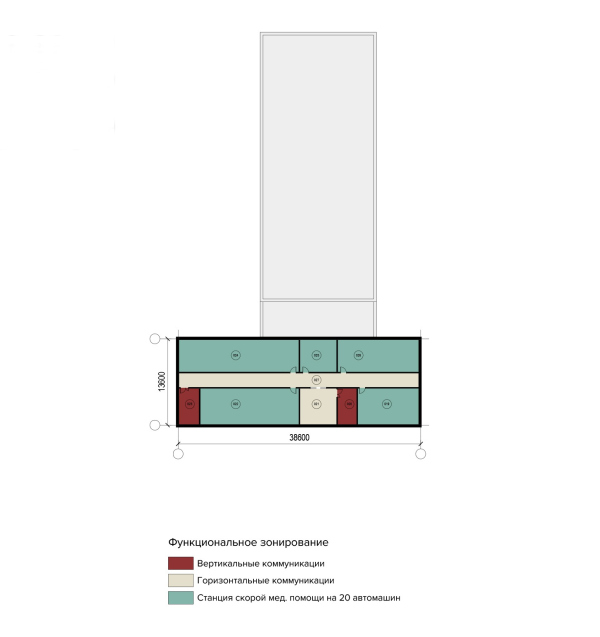 Health Constructor. Plan of the first floor of the ambulance stationCopyright: © UNK project Health Constructor. Plan of the second floor of the ambulance stationCopyright: © UNK project |
|
